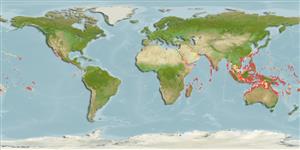Common names from other countries
Environment: milieu / climate zone / depth range / distribution range
Ecologie
marien rifbewoner; standvastig; diepte 1 - 40 m (Ref. 90102). Tropical; 30°N - 30°S
Indo-West Pacific: Red Sea and East Africa to Samoa, north to southern Japan, south to Western Australia and New South Wales, including Lord Howe Island (Ref. 1602).
Grootte / Gewicht / Leeftijd
Maturity: Lm ? range ? - ? cm
Max length : 40.0 cm SL mannelijk / geslacht onbekend; (Ref. 30573)
Dorsale stekels (totaal) : 13; Dorsale zachte stralen (totaal) : 20 - 23; Anale stekels: 3; Anale zachte stralen: 18 - 22.
Juveniles inhabit shallow protected areas, while adults prefer coastal reefs with heavy coral growth providing ample hiding places. Generally solitary or in pairs. Feeds on sponges, tunicates, and algae (Ref. 30573). The young are excellent aquarium fish and suitable for a community tank.
Levenscyclus en paargedrag
Maturities | Voortplanting | Spawnings | Egg(s) | Fecundities | Larven
Myers, R.F., 1991. Micronesian reef fishes. Second Ed. Coral Graphics, Barrigada, Guam. 298 p. (Ref. 1602)
Status op de Rode Lijst van het IUCN (Ref. 130435)
CITES (Ref. 128078)
Not Evaluated
Gevaar voor de mens
Harmless
Gebruik door de mens
Visserij: van minder commercieel belang; Aquarium: Commercieel
Tools
Speciale rapporten
Download XML
Internetbronnen
Estimates based on models
Preferred temperature (Ref.
115969): 24.7 - 29, mean 27.8 (based on 828 cells).
Fylogenetische diversiteitsindex (Ref.
82804): PD
50 = 0.5001 [Uniqueness, from 0.5 = low to 2.0 = high].
Bayesian length-weight: a=0.03236 (0.01300 - 0.08052), b=2.89 (2.71 - 3.07), in cm Total Length, based on LWR estimates for this Genus-body shape (Ref.
93245).
Trofisch niveau (Ref.
69278): 2.7 ±0.00 se; based on food items.
Weerstandsvermogen (Ref.
120179): laag, minimale populatieverdubbelingstijd 4,5-14 jaar (Preliminary K or Fecundity.).
Fishing Vulnerability (Ref.
59153): Moderate vulnerability (39 of 100).
